英语今日讲解
- 格式:doc
- 大小:98.50 KB
- 文档页数:19
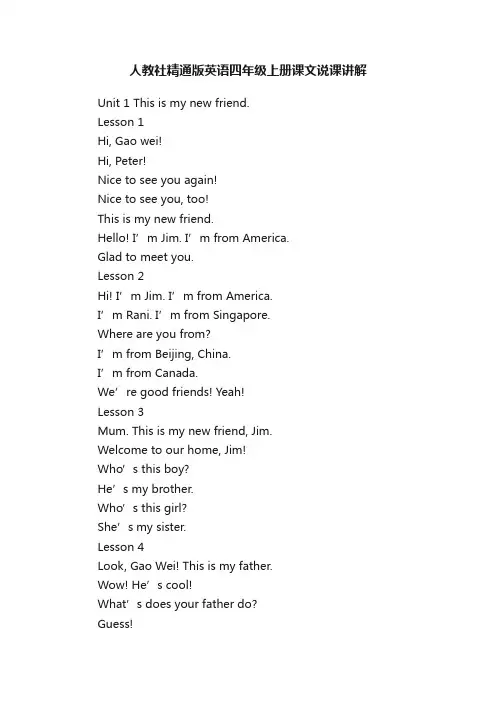
人教社精通版英语四年级上册课文说课讲解Unit 1 This is my new friend.Lesson 1Hi, Gao wei!Hi, Peter!Nice to see you again!Nice to see you, too!This is my new friend.Hello! I’m Jim. I’m from America.Glad to meet you.Lesson 2Hi! I’m Jim. I’m from America.I’m Rani. I’m from Singapore.Where are you from?I’m from Beijing, China.I’m from Canada.We’re good friends! Yeah!Lesson 3Mum. This is my new friend, Jim.Welcome to our home, Jim!Who’s this boy?He’s my brother.Who’s this girl?She’s my sister.Lesson 4Look, Gao Wei! This is my father.Wow! He’s cool!What’s does your father do?Guess!Is he a driver?No, he’s a teacher.Lesson 5Look! This is my mother.Oh, she’s beautiful!What’s does you r mother do?She’s a doctor.Oh, great!Lesson 6My mum is a TV reporter.Oh, Cool!What does your father do?Guess!Is he a teacher?No!A doctor?No!Oh!Be careful.Thank you.Look, Jim! That’s my father.Oh, your father is a policeman.Unit 2 What’s your number?Lesson 7Hi, Kate. This is my new friend. Sue.Hi, Sue. Pleased to meet you!Pleased to meet you, too.Which class are you in?I’m in Class Two, Grade Three. How about you? I’m in Class One. Grade Four.Lesson 8One, two, three, go!What’s you r number?I’m number fourteen.What’s your number?I’m number thirteen.Lesson 9 Hi, Mimi! What’s your number?I’m number six!What’s one and two?It’s three.That’s right! And what’s seven and eight? Um… it’s fifteen.Good!Lesson 10 Good morning class!Good morning, Mr Zhang.Let’s count from one to eighteen.One!Two!Three!Four!What’s eight and nine?It’s seventeen.Very good!Lesson 11 Wake up! Wake up, Peter.What’s the time, Mum?It’s 7:20.Oh, no! I’m late!Have some milk.No, thanks!Lesson 12 What’s one and two?It’s three.Good!What’s eight and seven? Um… fif teen.What’s ten and ten? Twenty!No!Why not?Look! Ten and ten.So, ten and ten is ten!Oh, that’s funny!Unit 3 It’s a pineapple. Lesson 13 Look! What’s this?A pear?An apple?Look! It’s an apple!Yes, it’s an apple.Guess! What’s this?It’s a pineapple.Right! It’s a pineapple. Lesson 14 What’s this? Look! It’s a banana. What’s that?Look! It’s a watermelon. Oh, it’s a big watermelon. Lesson 15What’s this in English?It’s a tomato.Do you like tomatoes? Yes, I do.Lesson 16 Hi, Kate. What’s that in English?It’s a carrot.Do you like carrots?Yes, I do. And I like cucumbers, too.Lesson 17 Hi! Let’s play a chain game.Ok!What’s this in English?It’s a green pepper.Do you like green peppers?Yes, I do.What’s this in English?It’s an eggplant.Do you like eggplants?No, I don’t. I like tomatoes.Lesson 18 I’m Micky. I’m smart.Excuse me. What’s this in English? It’s a carrot. And what’s this?It’s a cucumber.What’s that in English?I know! It’s a bat!Are you sure?Yes!Look!。
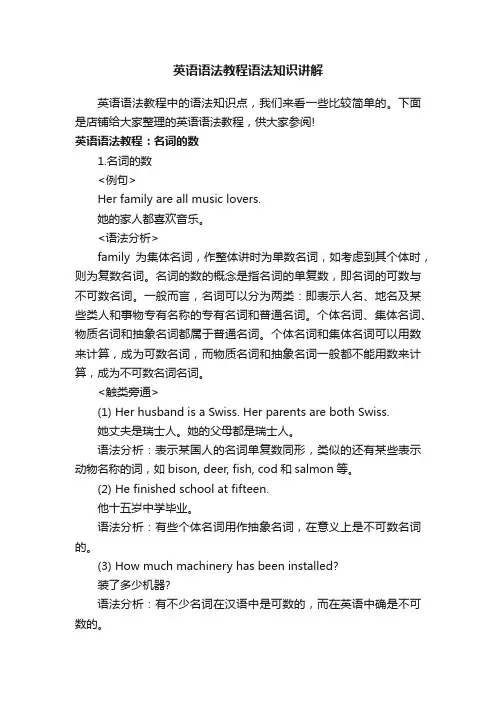
英语语法教程语法知识讲解英语语法教程中的语法知识点,我们来看一些比较简单的。
下面是店铺给大家整理的英语语法教程,供大家参阅!英语语法教程:名词的数1.名词的数<例句>Her family are all music lovers.她的家人都喜欢音乐。
<语法分析>family为集体名词,作整体讲时为单数名词,如考虑到其个体时,则为复数名词。
名词的数的概念是指名词的单复数,即名词的可数与不可数名词。
一般而言,名词可以分为两类:即表示人名、地名及某些类人和事物专有名称的专有名词和普通名词。
个体名词、集体名词、物质名词和抽象名词都属于普通名词。
个体名词和集体名词可以用数来计算,成为可数名词,而物质名词和抽象名词一般都不能用数来计算,成为不可数名词名词。
<触类旁通>(1) Her husband is a Swiss. Her parents are both Swiss.她丈夫是瑞士人。
她的父母都是瑞士人。
语法分析:表示某国人的名词单复数同形,类似的还有某些表示动物名称的词,如bison, deer, fish, cod和salmon等。
(2) He finished school at fifteen.他十五岁中学毕业。
语法分析:有些个体名词用作抽象名词,在意义上是不可数名词的。
(3) How much machinery has been installed?装了多少机器?语法分析:有不少名词在汉语中是可数的,而在英语中确是不可数的。
(4) There is a beauty in simplicity.朴实之中有一种美。
语法分析:在多数情况下抽象名词用于单数形式,某些时候,也可以在其前面加定冠词或不定冠词。
(5) Two beers, please.请来两杯啤酒。
语法分析:一般说来,物质名词是不可数的,因而没有复数形式,但有些物质名词用作可数名词可用来表示“一份”、“一杯”或“一种”等意义。
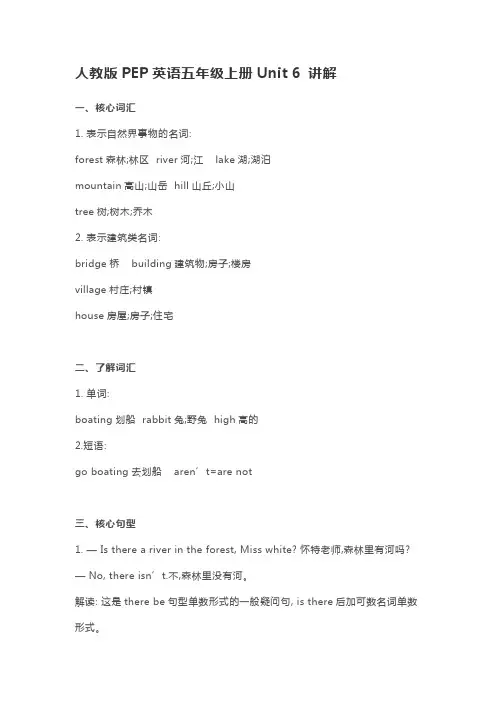
人教版PEP英语五年级上册Unit 6 讲解一、核心词汇1. 表示自然界事物的名词:forest森林;林区 river河;江 lake湖;湖泊mountain高山;山岳 hill山丘;小山tree树;树木;乔木2. 表示建筑类名词:bridge桥 building建筑物;房子;楼房village村庄;村镇house房屋;房子;住宅二、了解词汇1. 单词:boating划船 rabbit兔;野兔 high高的2.短语:go boating去划船 a ren’t=are not三、核心句型1. — Is there a river in the forest, Miss white? 怀特老师,森林里有河吗? — No, there isn’t.不,森林里没有河。
解读: 这是there be句型单数形式的一般疑问句, is there后加可数名词单数形式。
2. — Are there any lakes in the park?公园里有湖吗?— Yes, there are.是的,公园里有湖。
解读: 这是there be句型复数形式的一般疑问句,可以用来询问某处是否有某人或某物。
are there后面跟可数名词复数形式。
拓展: some和any都表示一些, some一般用在肯定句中, any用在疑问句和否定句中。
3. What a nice day!天气真好啊!解读:这是一个感叹句。
感叹句是表示人惊讶、恐惧、忧伤、愉快等感情的句子。
拓展: how引导的感叹句。
句型结构为“How+形容词/副词(+主语+谓语)!”4. Why not?为什么不呢?解读:这是日常生活中常用的口语,用来表示对对方提出建议的赞同。
四、了解句型1. Let’s go boating.我们去划船吧。
2. How many?有多少个?3. There is so much corn!里边有那么多玉米!解读: many和much都可以表示很多, many用来修饰可数名词的复数形式。
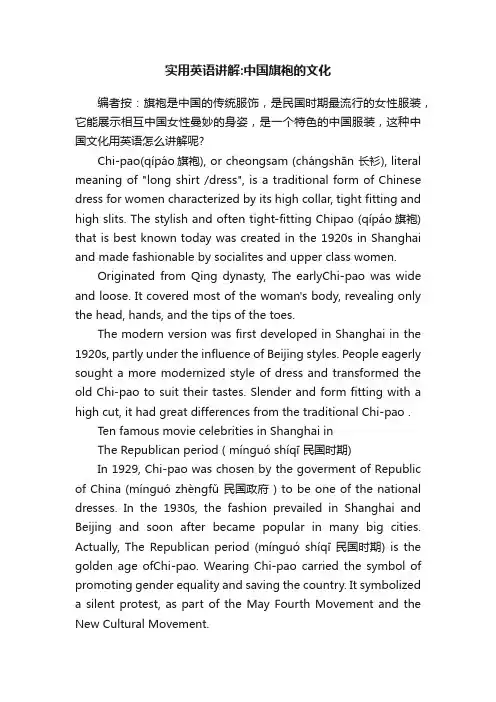
实用英语讲解:中国旗袍的文化编者按:旗袍是中国的传统服饰,是民国时期最流行的女性服装,它能展示相互中国女性曼妙的身姿,是一个特色的中国服装,这种中国文化用英语怎么讲解呢?Chi-pao(qípáo旗袍), or cheongsam (chángshān 长衫), literal meaning of "long shirt /dress", is a traditional form of Chinese dress for women characterized by its high collar, tight fitting and high slits. The stylish and often tight-fitting Chipao (qípáo旗袍) that is best known today was created in the 1920s in Shanghai and made fashionable by socialites and upper class women.Originated from Qing dynasty, The earlyChi-pao was wide and loose. It covered most of the woman's body, revealing only the head, hands, and the tips of the toes.The modern version was first developed in Shanghai in the 1920s, partly under the influence of Beijing styles. People eagerly sought a more modernized style of dress and transformed the old Chi-pao to suit their tastes. Slender and form fitting with a high cut, it had great differences from the traditional Chi-pao .Ten famous movie celebrities in Shanghai inThe Republican period ( mínguó shíqī 民国时期)In 1929, Chi-pao was chosen by the goverment of Republic of China (mínguó zhèngfǔ 民国政府 ) to be one of the national dresses. In the 1930s, the fashion prevailed in Shanghai and Beijing and soon after became popular in many big cities. Actually, The Republican period (mínguó shíqī 民国时期) is the golden age ofChi-pao. Wearing Chi-pao carried the symbol of promoting gender equality and saving the country. It symbolized a silent protest, as part of the May Fourth Movement and the New Cultural Movement.Two women wearing Chi-pao in a 1930s Shanghai advertisementFrom the 1950s to the 1970s, due to the influence of "movements" in China, especially the Chinese Cultural Revolution (1966-1976), the Chi-pao was seen as a feudal dress of the ancient times. It was abandoned as daily clothing, and people who wore Chi-pao were considered a political misbehavior at that time.Since 1980s, with the trend of renaissance of Chinese traditional culture, people in mainland China started to pay attention to the Chi-pao again. The Chi-pao is gaining popularity in films, beauty pageants, and fashion shows in both China and other countries all over the world.公众号:HanFan汉风。
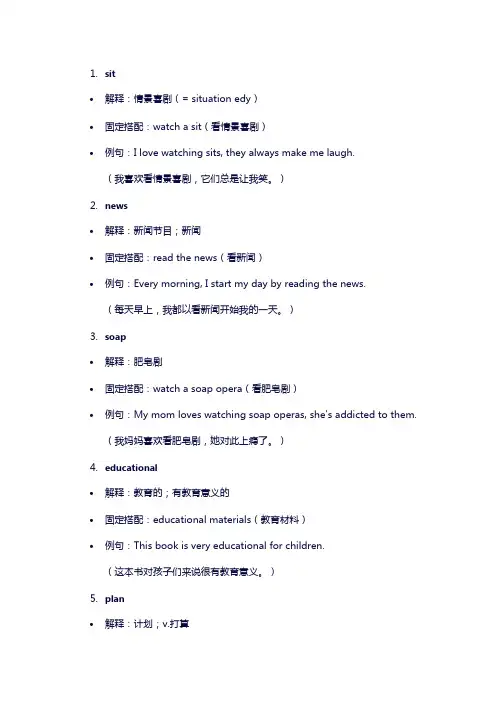
1.sit•解释:情景喜剧(= situation edy)•固定搭配:watch a sit(看情景喜剧)•例句:I love watching sits, they always make me laugh.(我喜欢看情景喜剧,它们总是让我笑。
)2.news•解释:新闻节目;新闻•固定搭配:read the news(看新闻)•例句:Every morning, I start my day by reading the news.(每天早上,我都以看新闻开始我的一天。
)3.soap•解释:肥皂剧•固定搭配:watch a soap opera(看肥皂剧)•例句:My mom loves watching soap operas, she's addicted to them.(我妈妈喜欢看肥皂剧,她对此上瘾了。
)cational•解释:教育的;有教育意义的•固定搭配:educational materials(教育材料)•例句:This book is very educational for children.(这本书对孩子们来说很有教育意义。
)5.plan•解释:计划;v.打算•固定搭配:make a plan(制定计划)•例句:I plan to travel to Europe next year.(我计划明年去欧洲旅行。
)6.hope•解释:v.&n.希望•固定搭配:hope to do sth.(希望做某事)•例句:I hope to bee a doctor in the future.(我希望将来成为一名医生。
)7.find out•解释:查明;弄清•固定搭配:find out the truth(查明真相)•例句:I'll find out who did this.(我会查明是谁做的。
)8.discussion•解释:讨论;商量•固定搭配:have a discussion about sth.(关于某事进行讨论)•例句:We had a long discussion about the project last night.(我们昨晚对这个项目进行了长时间的讨论。
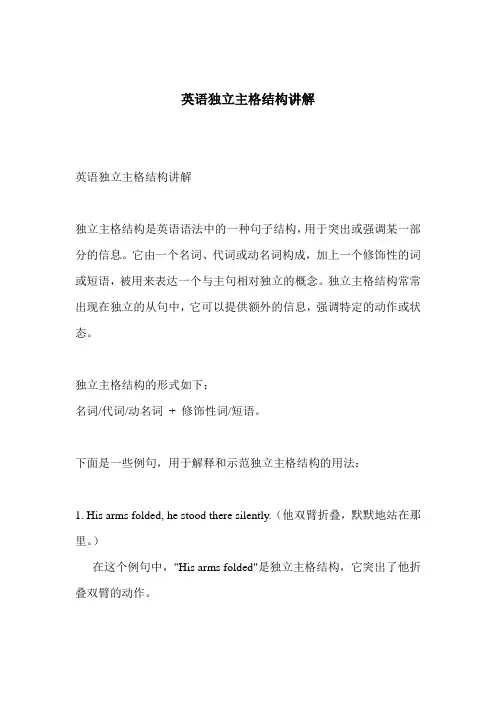
英语独立主格结构讲解英语独立主格结构讲解独立主格结构是英语语法中的一种句子结构,用于突出或强调某一部分的信息。
它由一个名词、代词或动名词构成,加上一个修饰性的词或短语,被用来表达一个与主句相对独立的概念。
独立主格结构常常出现在独立的从句中,它可以提供额外的信息,强调特定的动作或状态。
独立主格结构的形式如下:名词/代词/动名词+ 修饰性词/短语。
下面是一些例句,用于解释和示范独立主格结构的用法:1. His arms folded, he stood there silently.(他双臂折叠,默默地站在那里。
)在这个例句中,"His arms folded"是独立主格结构,它突出了他折叠双臂的动作。
2. The sun shining brightly, we decided to go for a picnic.(阳光灿烂地照耀着,我们决定去野餐。
)"The sun shining brightly"是独立主格结构,它描述了阳光灿烂的状态。
3. The rain having stopped, they continued their journey.(雨停了,他们继续他们的旅程。
)"The rain having stopped"是独立主格结构,它表示雨已经停止的状态。
4. The baby crying in the crib, she rushed to comfort him.(婴儿在婴儿床上哭,她匆忙前去安慰他。
)"The baby crying in the crib"是独立主格结构,它描述了婴儿在婴儿床上哭的动作。
需要注意的是,独立主格结构在句子中通常是非限定性的,它与主句之间存在一定的解释或补充关系。
独立主格结构可以用逗号与主句分开,但也可以使用破折号或括号等标点符号来表示。
总而言之,独立主格结构是一种用于突出或强调特定动作或状态的句子结构。
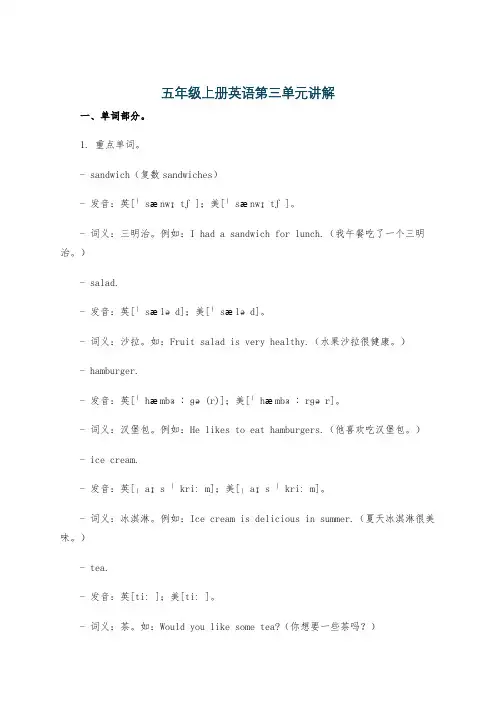
五年级上册英语第三单元讲解一、单词部分。
1. 重点单词。
- sandwich(复数sandwiches)- 发音:英[ˈsænwɪtʃ];美[ˈsænwɪtʃ]。
- 词义:三明治。
例如:I had a sandwich for lunch.(我午餐吃了一个三明治。
)- salad.- 发音:英[ˈsæləd];美[ˈsæləd]。
- 词义:沙拉。
如:Fruit salad is very healthy.(水果沙拉很健康。
)- hamburger.- 发音:英[ˈhæmbɜːɡə(r)];美[ˈhæmbɜːrɡər]。
- 词义:汉堡包。
例如:He likes to eat hamburgers.(他喜欢吃汉堡包。
)- ice cream.- 发音:英[ˌaɪs ˈkriːm];美[ˌaɪs ˈkriːm]。
- 词义:冰淇淋。
例如:Ice cream is delicious in summer.(夏天冰淇淋很美味。
)- tea.- 发音:英[tiː];美[tiː]。
- 词义:茶。
如:Would you like some tea?(你想要一些茶吗?)2. 词汇拓展。
- drink(名词:饮料;动词:喝)- 作为名词,例如:There are many kinds of drinks in the supermarket.(超市里有很多种饮料。
)- 作为动词,例如:I drink a glass of water every morning.(我每天早上喝一杯水。
)- food(食物)- 例如:We need to buy some food for the party.(我们需要为聚会买一些食物。
)二、句型部分。
1. 询问他人想吃(喝)什么的句型。
- What would you like to eat/drink?- 这是一个用来询问他人想要吃或者喝什么的常用句型。
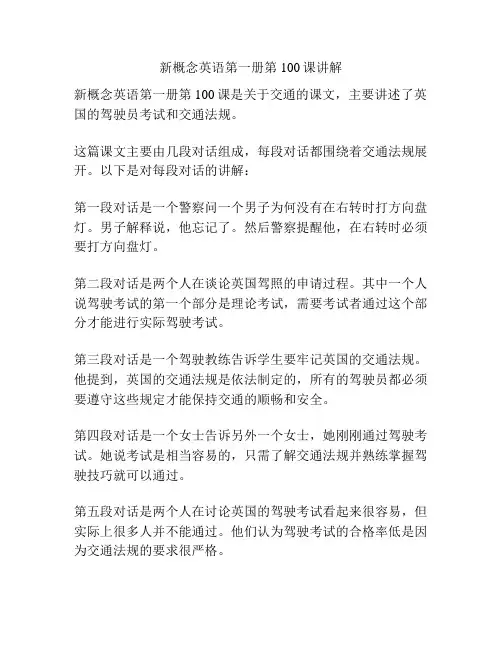
新概念英语第一册第100课讲解
新概念英语第一册第100课是关于交通的课文,主要讲述了英国的驾驶员考试和交通法规。
这篇课文主要由几段对话组成,每段对话都围绕着交通法规展开。
以下是对每段对话的讲解:
第一段对话是一个警察问一个男子为何没有在右转时打方向盘灯。
男子解释说,他忘记了。
然后警察提醒他,在右转时必须要打方向盘灯。
第二段对话是两个人在谈论英国驾照的申请过程。
其中一个人说驾驶考试的第一个部分是理论考试,需要考试者通过这个部分才能进行实际驾驶考试。
第三段对话是一个驾驶教练告诉学生要牢记英国的交通法规。
他提到,英国的交通法规是依法制定的,所有的驾驶员都必须要遵守这些规定才能保持交通的顺畅和安全。
第四段对话是一个女士告诉另外一个女士,她刚刚通过驾驶考试。
她说考试是相当容易的,只需了解交通法规并熟练掌握驾驶技巧就可以通过。
第五段对话是两个人在讨论英国的驾驶考试看起来很容易,但实际上很多人并不能通过。
他们认为驾驶考试的合格率低是因为交通法规的要求很严格。
总的来说,这篇课文主要讲述了英国的驾驶员考试和交通法规。
通过这些对话,读者可以了解到英国的交通法规以及驾驶考试的流程和要求。
课文内容简单明了,适合初学者阅读和学习。
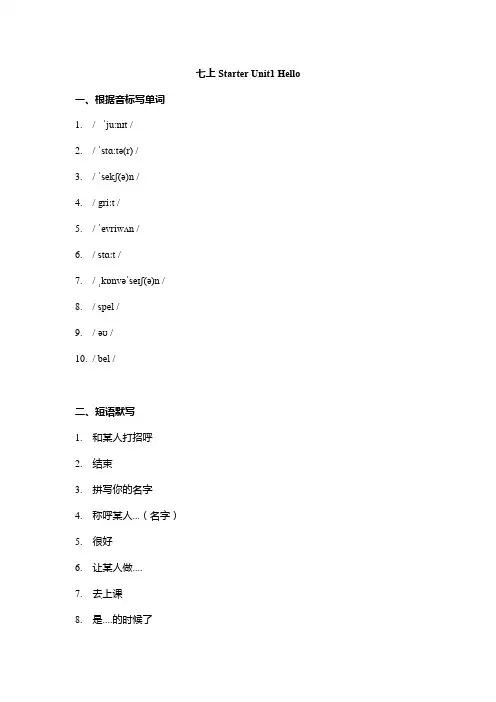
七上Starter Unit1 Hello一、根据音标写单词1./ ˈju:nɪt/2./ ˈstɑ:tə(r) /3./ ˈsekʃ(ə)n /4./ griːt /5./ ˈevriwʌn /6./ stɑːt /7./ ˌkɒnvəˈseɪʃ(ə)n /8./ spel /9./ əʊ /10./ bel /二、短语默写1.和某人打招呼2.结束3.拼写你的名字4.称呼某人...(名字)5.很好6.让某人做....7.去上课8.是....的时候了二、重点知识讲解1. hello&hihello “你好”,是朋友、亲人或者熟人之间非正式的问候语,可以用来表示问候、打招呼或引起对方注意,回答时用hello或hi均可。
hi 和hello一样也是“你好”的意思,在美国用的非常普遍,不仅用于熟人之间,也用于陌生人之间,比hello更简洁和随便,尤其用于擦肩而过的打招呼。
2.Good morning.“Good morning.”意为“早上好,上午好。
”,适用于比较正式客气的场合,用于早晨或上午(中午12点前)向他人问候。
“Good afternoon.”,下午好。
用于下午12点到18点这一时间段。
“Good evening.”,晚上好。
用于晚上18点到21点这一时间段。
Good night!晚安(晚间告别用语)3.How are you? 你(身体)好吗?-I'm fine,thanks. How are you?我很好,谢谢。
你好吗?—I'm OK.我很好。
有时出于礼貌还要反问对方的身体状况:How are you? / And you? 我很好。
谢谢。
你呢?应答语一般是:(I’m) fine/OK, too. 我也很好练习一、单选1.—I _______ a student. _______ you a teacher?—Yes, I am.A.am;Am B.is;Are C.am;Are D.are;Is 2.This is my T-shirt. His T-shirt __________ yellow.A.is B.am C.are3.I ________ in Class 3 and my sisters ________ in Class 2.A.am; is B.am; are C.are; am D.is; are 4.Look! Some apples ________ on the box.A.is B.are C.am D.be5.I ________ a boy, and Helen ________ a girl.A.am;is B.is;am C.am;are D.are;am6.Tom and Jack ________ friends.A.is B.am C.are D.be7.— ________ you Miss Read?—Yes, my name ________ Sue Read.A.Are, am B.Are, is C.Is, are D.Is, is8.________ Gina.This is ________ book.A.I’m, my B.I’m , an C.She’s, his D.He’s, her 9.—Hello, I’m Gina.—________A.Hi, Gina. I’m Alan. B.Good morning. C.Yes, I am.D.How are you?10.________ name is Helen and ________ name is Frank.A.Her; her B.His; his C.Her; his D.His; her 11.Look! Some keys ________ on the desk.A.is B.am C.are D.be 12.I ________ a teacher but you ________ students.A.is; am B.am; are C.am; is D.am; are 13.Our shorts ________ only 22 dollars.A.am B.is C.are 14.Tom and I _________ good friends.A.am B.is C.are D./ 15.—How ______ your mother?—She _______ fine.A.am; is B.is; is C.is; am D.are; is二、用所给词的适当形式填空1.This is _____(I)quilt.2.What’s_____(you)name?3.This is a girl, and ____(she) name is Kate.4.I am Kate Smith._____(I) last name is Smith.5.This is my cat.____(it) name is Mimi.6.The boy’s name is Peter Jones. Peter is (he) first name. 7.— Is White (you) last name?— Yes, it is.8.My telephone number (be) 267-5891.9.I don’t know (不知道) ( he) phone number. 10.—What’s (she) last name?—Green.三、连词成句1.he, is, Jack_________________________?, his, Mike, is_________________________.3.friend, is, my, Gina_________________________.4.in, are, you, China_________________________?5.my, she, not, friend, is___________________________.四、句型转换1.Her name is Gina .(对划线部分提问)______ her name ?2.I’m Li Lei .(改为同义句)______ ______ is Li Lei .3.She is Lingling .(改为一般疑问句并做肯定回答)—______ ______ Lingling ?—______ , she ______ .4.My last name is Smith . My first name is John .(合并一句)My name is ______ ______ .5.My friend is Jack .(改为同义句)Jack ______ ______ ______ .。
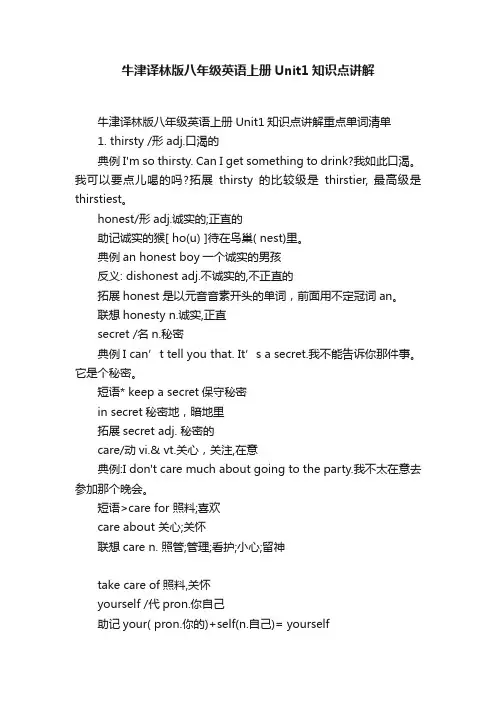
牛津译林版八年级英语上册Unit1知识点讲解牛津译林版八年级英语上册Unit1知识点讲解重点单词清单1. thirsty /形adj.口渴的典例I'm so thirsty. Can I get something to drink?我如此口渴。
我可以要点儿喝的吗?拓展thirsty的比较级是thirstier, 最高级是thirstiest。
honest/形adj.诚实的;正直的助记诚实的猴[ ho(u) ]待在鸟巢( nest)里。
典例an honest boy一个诚实的男孩反义: dishonest adj.不诚实的,不正直的拓展honest是以元音音素开头的单词,前面用不定冠词an。
联想honesty n.诚实,正直secret /名n.秘密典例I can’t tell you that. It’s a secret.我不能告诉你那件事。
它是个秘密。
短语* keep a secret保守秘密in secret秘密地,暗地里拓展secret adj. 秘密的care/动vi.& vt.关心,关注,在意典例:I don't care much about going to the party.我不太在意去参加那个晚会。
短语>care for 照料;喜欢care about 关心;关怀联想care n. 照管;管理;看护;小心;留神take care of照料,关怀yourself /代pron.你自己助记your( pron.你的)+self(n.自己)= yourself典例Help yourself to some fish, Ann.安,请随便吃些鱼吧。
短语*enjoy yourself玩得开心by yourself独自地,独立地help yourself to... 请随便吃拓展yourself的复数形式为yourselves.6.magazine/n.杂志典例read many kinds of magazines拓展英语中“看”的不同表达(看书read a book看电影see/ watch a film看电视watch TV看黑板look at the blackboard看医生see the doctor看窗外look out of the window7. good-looking /形adj.好看的,漂亮的助记> good( adj.好的) +looking( adj.●.....相貌的)= good-looking典例>Lucy is a good-looking girl.露西是-个漂亮的姑娘。
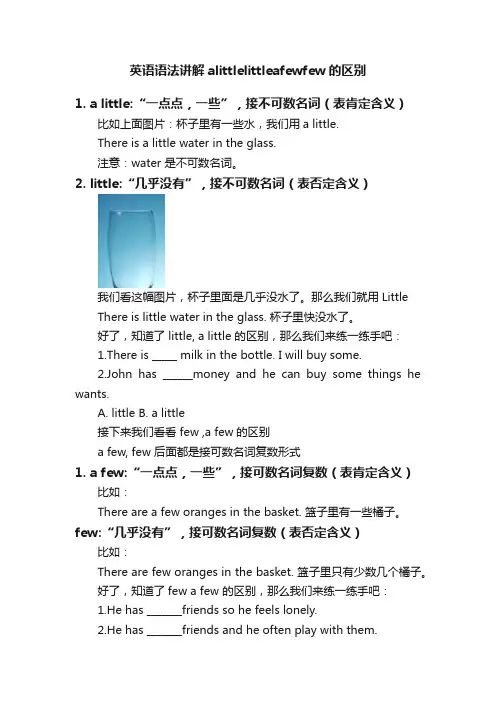
英语语法讲解alittlelittleafewfew的区别1. a little:“一点点,一些”,接不可数名词(表肯定含义)比如上面图片:杯子里有一些水,我们用a little.There is a little water in the glass.注意:water 是不可数名词。
2. little:“几乎没有”,接不可数名词(表否定含义)我们看这幅图片,杯子里面是几乎没水了。
那么我们就用LittleThere is little water in the glass. 杯子里快没水了。
好了,知道了 little, a little 的区别,那么我们来练一练手吧:1.There is _____ milk in the bottle. I will buy some.2.John has ______money and he can buy some things he wants.A. littleB. a little接下来我们看看 few ,a few的区别a few, few 后面都是接可数名词复数形式1. a few:“一点点,一些”,接可数名词复数(表肯定含义)比如:There are a few oranges in the basket. 篮子里有一些橘子。
few:“几乎没有”,接可数名词复数(表否定含义)比如:There are few oranges in the basket. 篮子里只有少数几个橘子。
好了,知道了few a few 的区别,那么我们来练一练手吧:1.He has _______friends so he feels lonely.2.He has _______friends and he often play with them.A. fewB. a few 总结。
新版七年级上册英语单词讲解一、good [gud] adj.(形容词)1. 用法。
- 用于描述人或事物的性质,表示“好的;令人满意的”。
例如:This is a good book.(这是一本好书。
)- 还可以用于形容人的品质,如:He is a good boy.(他是一个好男孩。
)二、morning ['mɔ:niŋ] n.(名词)1. 用法。
- 指一天中的上午时段。
常与介词in搭配,构成短语“in the morning”(在上午)。
例如:I get up at six in the morning.(我早上六点起床。
)三、hello [hə'ləu] int.(感叹词)1. 用法。
- 用于打招呼,是一种比较随意、常用的问候语。
例如:Hello, Tom!(你好,汤姆!)四、afternoon [,ɑ:ftə'nu:n] n.(名词)1. 用法。
- 表示一天中的下午时段。
常与介词in搭配,构成短语“in the afternoon”(在下午)。
例如:We have a meeting in the afternoon.(我们下午有一个会议。
)五、evening ['i:vniŋ] n.(名词)1. 用法。
- 指一天中的傍晚或晚上时段。
常与介词in搭配,构成短语“in the evening”(在晚上)。
例如:I watch TV in the evening.(我晚上看电视。
)六、how [hau] adv.(副词)1. 用法。
- 用于询问方式、方法,可译为“如何;怎样”。
例如:How do you go to school?(你怎样去上学?)- 也可用于询问健康状况等,如:How are you?(你好吗?)七、are [ɑ:] v.(动词,be动词的复数形式)1. 用法。
- 用于第二人称(you)单复数和复数人称(we,they等)后面,表示“是”。
例如:You are my friend.(你是我的朋友。
2024新版七年级上册英语starter单词讲解1.unit /ju:nit/n.单元 a unit一个单元2.starter /sta:tə(r)/unit 过渡单元There are three starter units in this book.3.section /ˈsekʃən/n.部分;地区a busy section of road交通繁忙路段the smoking section吸烟区4.greet /gri:t/v招呼;问候greets/greeted/greeting(s) 互相问候greet each other5.spell/spel/v用字母拼;拼写spells/spelt/spelling He is good at spelling words.6.start /sta:t/v 开始;着手start to do something/ start doing something7.conversation /ˌkɒnvəˈseɪʃən/ n.谈话;交谈(可数或不可数)have a long conversation with her8.bell /bel/n.铃(声);钟(声) Here comes a bicycle bell.9.Helen /ˈhelən/海伦Ella /ˈelə/埃拉Emma/ˈema/埃玛Peter /ˈpi:tə(r)/ 彼得Brown/braun/布朗10.PLA/ˌpi:elˈei/abbr中国人民解放军PRC /pi:a:(r)'si:/abbr: 中华人民共和国11.VR /vi:'a:(r)/abbr: 虚拟现实12.CD/si:'di:/abbr光盘some CDs13.UN/ju:'en/abb:联合国 a UN peacekeeping planler/'mɪlə(r)/米勒15.bottle/botl/n瓶子There are two bottles of milk on the table.16.eraser /ɪ'relzə(r)/n橡皮Here is an eraser for you,Millie.17.key /ki:/n钥匙;关键I lost the key to the door.我丢了门的钥匙。
高一英语第四单元讲解以下是为您生成的高一英语第四单元的部分讲解内容,包含单词、短语、用法及双语例句,您可以根据实际需求进行调整和补充。
---# 高一英语第四单元讲解## 一、重点单词1. **disaster** [dɪˈzɑːstə(r)] n. 灾难;灾祸- 英文释义:A sudden event, such as a flood, earthquake, or fire, that causes great damage or loss of life.- 双语例句:The earthquake was a terrible disaster. (这次地震是一场可怕的灾难。
)- 用法:disaster 通常指造成重大破坏和人员伤亡的严重事件。
2. **rescue** [ˈreskjuː] v. & n. 营救;救援- 英文释义:To save someone or something from danger or harm; an act of saving someone or something from danger or harm.- 双语例句:The firemen rescued three children from the burning house. (消防员从燃烧的房子里救出了三个孩子。
)- 用法:“rescue sb. from...” 表示“从......营救某人”3. **damage** [ˈdæmɪdʒ] v. & n. 损害;破坏- 英文释义:To cause harm or injury to something; physical harm that reduces the value or usefulness of something.- 双语例句:The storm damaged many houses. (暴风雨损坏了许多房屋。
Unit 4 Life on Mars词句精讲精练词汇精练1. rapidrapid 作形容词,意为“快的,迅速的”。
例如:He made rapid progress in English. 他在英语方面取得了很快的进步。
【拓展】rapid,fast &quick2. large numbers oflarge numbers of 表示“许多,大量的”,相当于a large number of。
a number of 意为“许多……”,修饰可数名词复数。
做主语时,谓语动词用复数。
number 前可用large,small等修饰,以表示程度。
例如:Large numbers of students are playing games together. 许多学生正在一起玩儿游戏。
A number of villagers are planting trees on the hill. 许多村民正在山上植树。
3. journey, travel, trip, tour4. tastytasty 作形容词,意为“美味的,可口的”。
例如:The dishes are tasty. 这些菜很美味。
【拓展】(1)taste 为连系动词,意为“尝起来”,后接形容词,有时可接介词like。
例如:This tomato tastes good. 这个西红柿尝起来不错。
(2)taste也可以作名词,意为“味道,滋味”。
例如:This orange has sweet taste. 这种橘子有甜味。
5. kind(1)kind 作可数名词,意为“种类,类别,类型”,常与of连用构成短语,常见的有:a kind of (一种); different kinds of (不同种类的);all kinds of (各种各样的); 这些短语后可以接不可数名词或可数名词的单数或复数。
例如:The supermarket sells all kinds of goods. 超市出售各种各样的商品。
《三年级英语Let's Talk》讲解1. 概述在三年级的英语学习中,学生将开始接触日常对话和简单交流。
其中,Let's Talk 是一个重要的教学内容,旨在帮助学生初步学会在实际生活中进行简单的英语对话。
本文将从听说读写四个方面全面解读三年级英语 Let's Talk 的教学内容。
2. 听在三年级的英语学习中,学生开始接触简单的英语听力内容。
Let's Talk教学内容中,学生将会听到各种日常生活用语、问候语和简单的交流用语,例如“Hello”, “How are you?”, “What's your name?”, “I'm fine, thank you.”等。
这些内容涵盖了日常生活中最常见的对话场景,学生通过听力训练能够更好地理解和运用这些基本的英语表达。
3. 说Let's Talk 的核心内容就是英语口语的训练。
通过角色扮演、小组对话等形式,学生将尝试用英语进行简单的对话。
在这个阶段,老师可以引导学生进行模仿、操练,帮助他们逐渐掌握英语口语的基本表达方式和语调。
4. 读在 Let's Talk 的教学中,学生也需要进行一些简单的阅读训练。
这包括基本的对话场景阅读,让学生能够通过阅读理解对话内容,并初步领会其中的语言表达方式和交际技巧。
5. 写除了听、说、读,Let's Talk 的教学内容还应包括一定的书面表达训练。
这可能包括简单的日记写作、回信或是对话场景的书面复述。
通过这些书面练习,学生能够更好地巩固所学的口语表达,并逐渐培养起用英语进行书面交流的能力。
6. 个人观点对我来说,Let's Talk 是一个很有意义的教学内容。
这种让学生从小就开始接触并习得英语口语的教学方式,不仅能够帮助他们打下坚实的英语语言基础,更有利于培养他们对英语的兴趣和自信心。
在这个阶段,老师的引导和激励尤为重要,要让学生在轻松愉快的氛围中愿意尝试使用英语进行交流,从而潜移默化中提高他们的语言能力。
She saw right through him. 她看穿了他。
Curiosity killed the cat. 好奇心害死了一只猫。
(太好奇并不是一件好事。
)He’s a little down in the dumps. 他有点沮丧。
The country was experiencing brain drain. 那个国家经历了人才外流。
He’s his own man. 他自己做主。
He’s a square peg in a round hole. 他跟周围的人格格不入。
United we stand, divided we fall. 团结则存,分裂则亡。
We’re all in the same boat. 我们处境相同。
She’s got itchy feet. 她呆不住了,想尽快走。
They’re on the road. 他们正在旅途上。
It took the world by storm. 它使世人为之倾倒。
Everybody’s getting into the act. 人人都参与。
He’s just beating his head against the wall. 他只是在枉费心机。
That theory doesn’t hold water. 那个理论站不住脚。
She put her best foot forward. 她全力以赴。
All systems go. 一切就绪。
That scared the living daylights out of me. 那把我吓个半死。
He turned over a new leaf. 他改过自新了She’s on the warpath. 她正在气头上,要找人发火。
That left a bad taste in my mouth. 那件事给我留下了一个坏印象。
Like father, like son. 有其父必有其子。
Boys will be boys. 孩子总是孩子嘛!She set him straight. 她帮他正确认识事情。
That threw her for a loop. 那令她大吃一惊。
Look before you leap. 三思而后行。
The sky’s the limit. 花钱没底。
He gave her a left-handed compliment. 他虚情假意地恭维了她一句。
She put him in his place. 她煞掉他的气焰,使他安分守己。
She followed in her father’s footsteps. 她继承了父亲的事业。
They were forced to eat their words. 他们被迫收回以前说过的话。
Her words went in one ear and out the other. 她的话被当作耳边风。
He stood his ground. 他坚持立场,毫不让步。
Let’s jazz it up a little. 我们让它变得生动些吧。
He’s got the blues. 他变得闷闷不乐。
An ounce of prevention is worth a pound of cure. 一分预防胜于七分治疗。
Talk is cheap. 光说不做毫无意义。
She was sawing logs all night. 她整晚鼾声不断。
Your love is better than chocolate. 你的爱比巧克力还甜蜜。
It’s a real godsend. 这是上天的恩赐。
A friend in need is a friend indeed. 患难朋友才是真朋友。
He’s got money to burn. 他的钱多得花不完。
She gave him the business. 她把他训斥了一顿。
Keep a stiff upper lip. 要坚定沉着。
She handled him with kid gloves. 她小心谨慎地对待他。
Keep your wits about you. 保持冷静。
Cross your fingers. 祈求好运吧。
It was a labor of love. 这份工作是出于爱好而做的。
We were really in the dark. 我们真的一无所知。
They really hung in there. 他们真的毫不退却。
He gave her a snow job. 他用花言巧语蒙骗她。
She was left on her own to sink or swim. 她被任由自生自灭。
Who knows what might happen in the heat of the moment? 谁知道情急之下会发生什么事?He only cries once in a blue moon. 他很少哭。
All’s fair in love and war. 恋爱和战争是不择手段的。
He never had a fighting chance. 他从没有机会一博。
She’s a big cheese. 她是个重要人物。
In advance ahead of time,beforehandIt’s not child’s play. 这不是简单的事。
She’s a busy beaver. 她工作很努力。
Where’s the beef? 抱怨的主要原因是什么?They’ll have to beef up their defences. 他们必须强化他们的辩词。
This stuff is the cat’s meow. 这个东西太棒了!The university beefed up its staff. 那所大学扩充了不少人员。
They say the pen is mightier than the sword. 他们说笔锋胜于武力。
Let’s cut to the chase. 我们言归正传。
They’re down in the dumps. 他们很沮丧。
She’s taking baby steps. 她一步一步地做此事。
You should try to strike a happy medium. 你应该试着达成和解。
They weren’t one big happy family. 他们相处得不好。
They don’t want to muscle in. 他们不想强行介入。
Bully for her! 她做得很棒!Don’t forget that money talks. 别忘了,有钱能使鬼推磨We should read between the lines. 我们应该体会言外之意。
Don’t stress out! 不要给自己太大压力!He’s stressing the point. 他强调重点。
The company blazed a trail in designing software. 这家公司是软件设计行业的先驱。
If you want to make an omelet, you have to break some eggs. 要想达到目的,就必须付出代价。
She was cut from different cloth. 她独树一帜。
It’s all there in black and white. 有白纸黑字为证。
He had blinders on. 他眼界狭窄。
Keep your eyes peeled. 你得小心一点。
Hindsight is 20/20. 事后再说当然容易。
This is no laughing matter. 这是很严肃的事情。
She’s a real class act. 她真是雍容华贵。
I can’t stomach it. 它让我难以忍受。
That made him sit up and take notice. 那件事让他警觉起来。
A picture is worth a thousand words. 眼见为实,耳听为虚。
It’s better to err on the side of caution. 谨慎些总比犯错好。
He laughed it off. 他一笑置之。
She had stars in her eyes. 她眼中闪着光。
He’s in the money. 他发了笔横财。
He was wet behind the ears. 他还年轻,没有经验。
She wears the pants in the family. 她当家作主。
She’s neither fish nor fowl. 她不伦不类的,有点古怪。
She had to be on her toes. 她必须保持警觉。
He’s tempting fate. 他太冒险了。
We’ve been spoon-fed all our lives. 我们这一辈子受的都是填鸭式教育。
She took issue with it. 她对这件事持异议。
It takes two to tango. 一个巴掌拍不响。